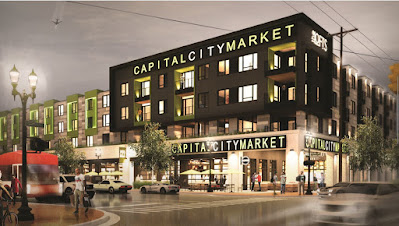Demolition crews hired by the Cleveland Clinic Foundation appeared this week along Chester Avenue between East 89th and 90th streets to begin tearing down three solid structures with a long history of charitable service in the city.
The structures -- including two historic, converted houses -- were part of the ORCA House's rehabilitation center for adults suffering from addictions. The demolitions appeared to be a rush job, even though a Cleveland Clinic spokesperson said the large health care system has no plans for developing the property.
ORCA House, now part of the Signature Health network, is one of the oldest African-American-founded substance abuse centers in the country. It was established in 1942 as the Outhwaite Recovery Center for Alcoholics.
Cleveland Clinic acquired the ORCA House properties in October of 2017 for $945,000 according to county records. Signature Health closed the 28-bed residential treatment facility with no replacement in the city of Cleveland readily available. All three structures were rated to be in good condition by Cuyahoga County tax appraisers.
ORCA House treatment inquires are being referred to another center, called Matt Talbot for Recovering Men, 6753 State Rd, Parma, according to an ORCA House representative. Although only eight miles away, it takes two buses and more than an hour of travel to reach the Parma center.
ORCA House's Web site indicates that a new center is opening in 2020 to replace the old facility at 1905 E. 89th St. However, no address for the new location is identified and no other information is available on the Web site. A phone message left with Signature Health's marketing and public relations department was not returned prior to publication.
Last week, Cleveland Clinic applied for and got three separate demolition permits with the city's Building & Housing Department to level the three ORCA House structures, city records show.
One permit is for the 6,256-square-foot house at the front of the property at 1905 E. 89th. Another is for the newer, 4,690-square-foot transient housing structure to the rear of the property. And the third is for a 3,392-square-foot house at 1914 E. 90th, used as the ORCA House women's facility which is adjacent to ORCA's East 89th property.
Only a week later, demolition equipment showed up next to the ORCA House. This follows Cleveland Clinic's purchase and demolition last fall of another house nearby -- a home at 1925 E. 89th. The year before, the health system demolished two other neighboring homes it bought since 2016, located at 1911 and 1915 E. 89th.
But despite all of these acquisitions and demolitions of structurally sound homes, Cleveland Clinic apparently has yet to identify a use for any of these properties.
'We are still determining plans for this land," said Angela Smith, senior director of corporate communications for the Cleveland Clinic Foundation.
Even if the Cleveland Clinic had plans, it probably wouldn't be able to act on them anytime soon. Some of its major capital construction projects have been pushed back to 2021 due to the coronavirus pandemic. That has put on hold projects like the 150,000-square-foot expansion of the Cole Eye Institute and the new 400,000-square-foot Neurological Institute.
"Some of our planned capital spending projects were delayed this year in order to preserve resources needed to support patient care, as well as our caregivers and our community," Smith said.
Despite that, Cleveland Clinic now owns all of the land between East 89th and East 90th, from Chester south to the Stanley Shalom Zielony Plaza on Euclid Avenue -- with one exception. That is a century-old walk-up apartment building bought in 2018 and renovated last year by Meilin Liu, an Alameda, Calif.-based real estate broker.
She said she bought and renovated the 12-unit, 11,121-square-foot apartment building, the type which used to be common throughout the Hough neighborhood to the north, because of the proximity of the Cleveland Clinic. But she said she hasn't been approached by the health system to acquire her property.
"I don't know why they didn't," Liu said. "We are completely invested in it (our property). Buying it is not going to be cheap."
North of Chester along East 90th, much of the land here has been acquired by a growing real estate developer, the Inspirion Group of Cleveland, public records show. Among the acquisitions by affiliates of Inspirion are one house, eight walk-up apartment buildings from the early 1900s and more than a dozen parcels.
The development firm announced plans last year for demolishing all structures on this street and building modern apartment buildings of about five stories each. Although demolition is underway, Inspirion hasn't advanced its construction plans through the city approvals process. Inspirion principal Lemma Getachew didn't respond to an e-mail seeking an update about their plans for these properties.
The ORCA House home on East 89th has a history going back to well before the nonprofit organization took it over. The house was built in 1895 for Henry Trenkamp Sr., founder of the Trenkamp Stove Co.
Architect of this house was Fenimore C. Bate who designed many fine homes in the late-19th century for Cleveland's growing upper class. One of Bate's most famous works is Gray's Armory at Bolivar Street and Prospect Avenue downtown.
One of Trenkamp's sons, Herman Trenkamp, helped found the Catholic Charities Corp. of Cleveland. His family donated the house after Herman's death in 1943 to charity. The house has been in the hands of charities ever since. The ORCA House expanded to the secondary residential building and the home for women's programs directly behind it at 1914 E. 90th.
END





























